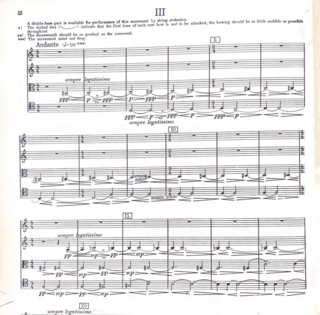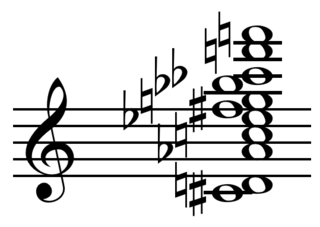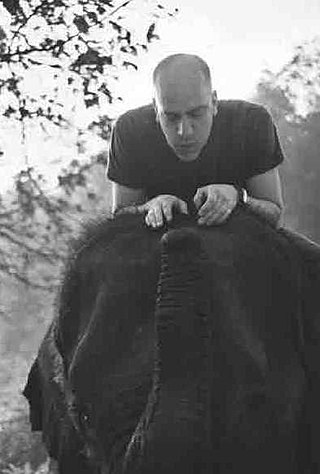Related Research Articles

The term string quartet refers to either a type of musical composition or a group of four people who play them. Many composers from the mid-18th century onwards wrote string quartets. The associated musical ensemble consists of two violinists, a violist, and a cellist. The double bass is almost never used in the ensemble mainly because it would sound too loud and heavy.

The Juilliard String Quartet is a classical music string quartet founded in 1946 at the Juilliard School in New York by William Schuman. Since its inception, it has been the quartet-in-residence at the Juilliard School. It has received numerous awards, including four Grammys and membership in the National Academy of Recording Arts and Sciences Hall of Fame. In February 2011, the group received the NARAS Lifetime Achievement Award for its outstanding contributions to recorded classical music.

Stuart Oliver Knussen was a British composer of contemporary classical music and conductor. Among the most influential British composers of his generation, his relatively few compositions are "rooted in 20th-century modernism, [but] beholden to no school but his own"

Ruth Crawford Seeger was an American composer and musicologist. Her music heralded the emerging modernist aesthetic, and she became a central member of a group of American composers known as the "ultramoderns". She composed primarily during the 1920s and 1930s, turning towards studies on folk music from the late 1930s until her death. Her music influenced later composers including Elliott Carter.

Ruth Crawford Seeger's String Quartet (1931) is "regarded as one of the finest modernist works of the genre". It was funded by the Guggenheim Foundation and written in the spring of 1931, during Crawford's time in Berlin. It was first published in the New Music Edition in January 1941.

In musical composition, a sound mass or sound collective is the result of compositional techniques, in which, "the importance of individual pitches", is minimized, "in preference for texture, timbre, and dynamics as primary shapers of gesture and impact", obscuring, "the boundary between sound and noise".

Anahid Marguerite Ajemian was an American violinist of Armenian descent. Her career in contemporary music began from her desire to help young composers of her generation get their compositions performed. Additionally, she enjoyed performing the music of established contemporary composers. She included these composers with the traditional repertoire in her performances.
Joel Krosnick is an American cellist who has performed as a soloist, recitalist, and chamber musician throughout the world for over 40 years. As a member of the Juilliard String Quartet from 1974 to 2016, he performed the great quartet literature throughout North America, Europe, Asia, and Australia.

The Pacifica Quartet is a professional string quartet based in Bloomington, Indiana. Its members are: Simin Ganatra, first violin; Austin Hartman, second violin; Mark Holloway, viola; and Brandon Vamos, cello. Formed in 1994 by Ganatra and Vamos with violinist Sibbi Bernhardsson and violist Kathryn Lockwood, the group won prizes in competitions such as the 1996 Coleman Chamber Music Competition, the 1997 Concert Artists Guild Competition, and the 1998 Naumburg Chamber Music Competition. In 2001, violist Masumi Per Rostad replaced Lockwood. The group subsequently received Chamber Music America's prestigious Cleveland Quartet Award in 2002, the Avery Fisher Career Grant in 2006, and was named "Ensemble of the Year" by Musical America in 2009. In 2017, violinist Austin Hartman replaced Bernhardsson and violist Guy Ben-Ziony replaced Rostad.
The Esterhazy Quartet is an American string quartet founded in 1968 as the ensemble-in-residence of the University of Missouri and is composed of faculty members at the University of Missouri School of Music in Columbia. The Esterhazy Quartet's current members are:
Martin Boykan was an American composer known for his chamber music as well as music for larger ensembles.
Johanna Magdalena Beyer was a German-American composer and pianist. Among her best known compositions is IV for Percussion Ensemble (1936), the only work published during her lifetime.
American composer Elliott Carter's String Quartet No. 5 is a composition for string quartet. The work was composed between January and July 1995, as a commission for the Arditti Quartet by the city of Antwerp, by the Wittener Tage für neue Kammermusik, by the Festival d'Automne à Paris, and by Lincoln Center, New York. It was premiered by the Arditti Quartet in Antwerp at deSingel International Art Centre on September 19, 1995.

David Sulzer is an American neuroscientist and musician. He is a professor at Columbia University Medical Center in the departments of psychiatry, neurology, and pharmacology. Sulzer's laboratory investigates the interaction between the synapses of the cerebral cortex and the basal ganglia, including the dopamine system, in habit formation, planning, decision making, and diseases of the system. His lab has developed the first means to optically measure neurotransmission, and has introduced new hypotheses of neurodegeneration in Parkinson's disease, and changes in synapses that produce autism and habit learning.
The Vághy String Quartet is a Canadian string quartet known for its luscious and emotional sound, as talked about by the New York Times, as well as for its numerous performances throughout North America and Europe. Formed in 1965, the quartet has played and premiered many composers. It has also recorded many classical pieces, having a total repertoire of over 160 pieces. The quartet taught throughout Canada and won the 1977 Canadian Music Council award for best recording of the year.
String Quartet No. 2 (1954) is the second of six string quartets by the American composer Milton Babbitt.
Bernard Zaslav was an American viola soloist and chamber musician with an extensive recording and performance career. A founding member of The Composers Quartet in 1965, he went on to play with the Fine Arts Quartet, Vermeer Quartet, and the Stanford String Quartet. He has also performed and recorded as the Zaslav Duo with his wife, pianist Naomi Zaslav.
The Walden String Quartet was a chamber music ensemble formed in 1934 by members of the Cleveland Orchestra. It was originally the idea of violinist Homer Schmitt and cellist Robert Swenson, who met in 1927. They recruited violinist Bernard Goodman and violist Leroy Collins for the original group. The viola chair changed many times until John Garvey joined in 1948.
References
- ↑ "CHAMBER: COMPOSERS QUARTET". The New York Times. 1982-11-27.
- ↑ "The Carter Vogue", TIME Magazine, Feb. 10, 1975
- ↑ Tick, Judith. "Ruth Crawford Seeger's Different Tunes".
- ↑ "Elliott Carter: String Quartet No. 4", Notes, 48:2 (Dec. 1991), p. 689.
- ↑ New Grove Dictionary of Music and Musicians
- ↑ "About the Mt. Desert Festival of Chamber Music".
- ↑ New Grove Dictionary of Music and Musicians
- ↑ Composers String Quartet to Perform at Miller, Columbia University Record, Oct. 28, 1994, Vol. 20, No. 8